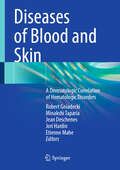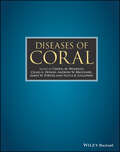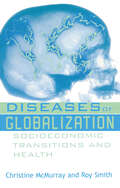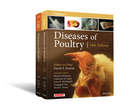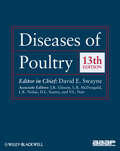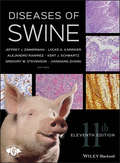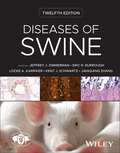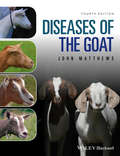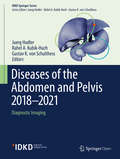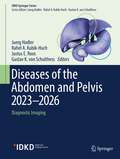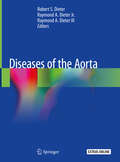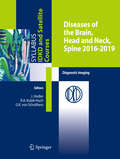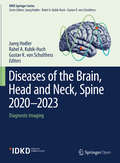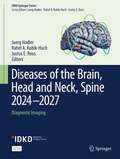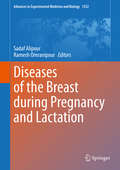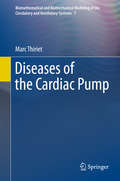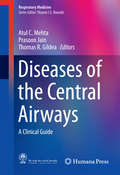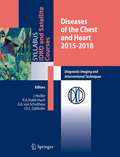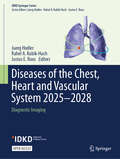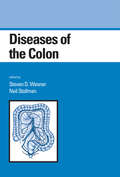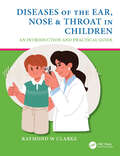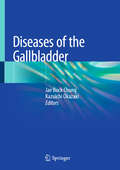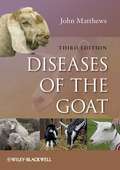- Table View
- List View
Diseases of Blood and Skin: A Dermatologic Correlation of Hematologic Disorders
by Robert Gniadecki Minakshi Taparia Jean Deschenes Jori Hardin Etienne MaheDiseases of the hematopoietic system often manifest themselves in the skin, and some manifestations are so typical that the dermatologist may be the first physician to detect the underlying blood disorder. More commonly, however, skin symptoms arise in the context of a known hematopoietic disease. This book reviews skin signs and symptoms that develop secondarily to underlying malignant or benign diseases of the hematopoietic system, and mainly built as a clinical text to support the physician in making a correct diagnosis and understanding the significance of skin signs for the prognosis and management of the hematological disease. The malignant hematological diseases comprise approximately 80% of the book, which reflects the spectrum of patients in hematology departments, as well as the experience of the authors. In addition to its pragmatic structure that enables the reader to find relevant information, tables are included for differential diagnoses and cross-referencing the skin sign with hematological diagnoses and vice versa. For each chapter, ample background information is provided to convey dermatologists the essence of hematological disorders. Likewise, to enhance understanding among hematologists, dermatological jargon is avoided and skin signs described in understandable terms, underscoring the patterns of the lesions and key features allowing the non-dermatologist clinician to differentiate one skin condition from another.This book is primarily for the physicians who see adult patients; to achieve consistency and readability, the work is meant as a monograph written by specialists in the field, who collaborate with one another on a daily basis. While not aiming to be an exhaustive reference work, it is built as an intelligible handbook that for the first time covers the cross-section of dermatology and hematology. The audience comprises dermatologists working in an academic or hospital setting, as well as hematologists and internists who manage patients with blood diseases in their daily clinical practice.
Diseases of Coral
by Craig A. Downs Cheryl M. Woodley Andrew W. Bruckner Sylvia B. Galloway James W. PorterCoral disease is quickly becoming a crisis to the health and management of the world's coral reefs. There is a great interest from many in preserving coral reefs. Unfortunately, the field of epizootiology is disorganized and lacks a standard vocabulary, methods, and diagnostic techniques, and tropical marine scientists are poorly trained in wildlife pathology, veterinary medicine, and epidemiology. Diseases of Coral will help to rectify this situation.
Diseases of Domestic Guinea Pigs (Library of Veterinary Practice #4)
by Virginia C. RichardsonThis book provides a comprehensive text covering all aspects of guinea pig medicine. This updated edition will be of value to veterinary surgeons and students, veterinary nurses, breeders and all those working in the animal care industry. Written in note form the book assists in the formulation of a diagnostic plan when the practitioner is faced with a sick animal. Sections on clinical signs, diagnoses and treatments, allow rapid reference in successive chapters on the reproductive, digestive, respiratory, musculoskeletal and urinary systems, the skin, head and neck, nervous system and husbandry. All the latest drug information has been included and full details of dose rates, contraindications and components of the proprietary preparations are listed in chapter 11. A new chapter has been written providing information on herbal and homeopathic remedies.
Diseases of Globalization: Socioeconomic Transition and Health
by Roy Smith Christine McMurrayThe emergence of a global economy has led to the erosion of local autonomy and national sovereignty with an associated emphasis on the spread of liberal, free-market economics. A clear divide is appearing between those benefiting from and those disadvantaged by this process. Among the most important consequences are changes in the patterns of health and the prevalence of disease. While infant mortality is declining in most countries, and many formerly prevalent diseases are being successfully tackled, the move from subsistence to cash economies brings with it changes in diet, alcohol consumption and high levels of smoking; with the result that non-communicable, 'lifestyle illnesses' such as heart disease and diabetes are spreading rapidly. Similarly, growing divisions of wealth add to the problem, bringing diseases relating to poverty and malnourishment as well as those caused by affluence and over-consumption. Issues covered in this book include equitable and sustainable modernization, the determinants of health, the process of marginalization, and survival strategies on the periphery. The authors draw on primary case study material, largely from societies in the Pacific region undergoing modernization, to provide invaluable information for tracking and assessing the full impacts of these changes.
Diseases of Poultry
by David E. Swayne Martine Boulianne Catherine M. Logue Larry R. McDougald Venugopal Nair David L. SuarezThe most complete and definitive reference to all aspects of poultry diseases, Diseases of Poultry, Fourteenth Edition has been fully revised and updated to offer a comprehensive survey of current knowledge. Updates the definitive reference of poultry health and disease Provides more clinically relevant information on management of specific diseases, contributed by clinical poultry veterinarians Offers information on disease control in organic and antibiotic-free production Presents more concise, streamlined chapters for ease of use Incorporates advances in the field, from new diagnostic tools and information to changes brought about by the increasing globalization and the re-emergence of zoonotic pathogens
Diseases of Poultry
by L. R. Mcdougald J. R. Glisson David E. Swayne V. L. Nair L. K. Nolan D. L. SuarezDiseases of Poultry is the most comprehensive reference for all aspects of poultry health and diseases, including pathogenesis, diagnostics, epidemiology, and control methods. Published in partnership with the American Association of Avian Pathologists, the Thirteenth Edition remains the international definitive reference, adding newer diagnostic methods and a new chapter on the emerging importance of zoonotic infections for poultry pathogens. Other updates include new high-quality photographs, additional discussion of conceptual operational biosecurity and disease control in organic production systems, and a greater emphasis throughout on the differences in disease incidence and treatments for the United States and other areas around the globe.Organized logically by disease type, the book offers detailed coverage of the history, etiology, pathobiology, diagnosis, and intervention strategies, as well as the economic and public health significance, for an exhaustive list of common and uncommon diseases. Diseases of Poultry, 13th Edition is an essential purchase for poultry veterinarians, veterinary diagnosticians, poultry scientists, students specializing in poultry health, and government officials who deal with poultry health in regulatory climate.
Diseases of Swine
by Alejandro Ramirez Kent J. Schwartz Gregory W. Stevenson Locke A. Karriker Jeffrey J. Zimmerman Jianqiang ZhangProvides a fully revised Eleventh Edition of the definitive reference to swine health and disease Diseases of Swine has been the definitive reference on swine health and disease for over 60 years. This new edition has been completely revised to include the latest information, developments, and research in the field. Now with full color images throughout, this comprehensive and authoritative resource has been redesigned for improved consistency and readability, with a reorganized format for more intuitive access to information. Diseases of Swine covers a wide range of essential topics on swine production, health, and management, with contributions from more than 100 of the foremost international experts in the field. This revised edition makes the information easy to find and includes expanded information on welfare and behavior. A key reference for anyone involved in the swine industry, Diseases of Swine, Eleventh Edition: Presents a thorough revision to the gold-standard reference on pig health and disease Features full color images throughout the book Includes information on the most current advances in the field Provides comprehensive information on swine welfare and behavior Offers a reorganized format to make the information more accessible Written for veterinarians, academicians, students, and individuals and agencies responsible for swine health and public health, Diseases of Swine, Eleventh Edition is an essential guide to swine health.
Diseases of Swine
by Kent J. Schwartz Locke A. Karriker Jeffrey J. Zimmerman Jianqiang Zhang Eric R. BurroughA comprehensively updated edition of the gold standard reference on swine health and disease This newly revised Twelfth Edition of Diseases of Swine is designed to serve as a comprehensive and detailed reference on swine health and disease. It offers swine health specialists the information and knowledge they need to effectively respond to and treat pig diseases. It provides coverage of individual pig and herd health, making the book an effective resource for addressing diseases at the farm, local, regional, and global levels. With contributions and updates from more than 100 international experts in swine health, this edition of Diseases of Swine provides improved organization and ease of access, allowing readers to quickly find the information they need. The new edition also includes new and updated chapters on surveillance, monitoring, and biosecurity, as well as information concerning new emerged and transboundary infectious agents. Readers will also find: A thorough introduction to herd evaluation and considerations of pig behavior and welfareComprehensive explorations of environment and health, including recommended air temperatures, minimum ventilation rates, and morePractical discussions on differential diagnosis of diseaseComplete coverage of drug pharmacology, therapy, and prophylaxis Written for practicing swine veterinarians, academicians, and veterinary students, Diseases of Swine, Twelfth Edition will also benefit professionals working with agencies responsible for swine health, public health, or zoonotic diseases.
Diseases of The Goat
by John G. MatthewsDiseases of the Goat, 4th Edition, is a revised and updated edition of the popular tool for veterinarians featuring of all aspects of goat medicine--from initial assessment and examination to diagnosis, treatment, and control of conditions. This highly practical, concise handbook is designed for frequent reference, and is suitable for all those treating and keeping goats. Provides information on to predators, euthanasia, post-mortem technique, and fracture repair Includes expanded coverage of a number of topics to appeal to a wider and more international audience especially in relation to poisonous plants Incorporates the impact of new developments in goat diseases, such as the geographical spread of exotic diseases into new regions
Diseases of the Abdomen and Pelvis 2018-2021: Diagnostic Imaging - Idkd Book (IDKD Springer Series)
by Gustav K. Schulthess Rahel A. Kubik-Huch Juerg HodlerThis open access book deals with imaging of the abdomen and pelvis, an area that has seen considerable advances over the past several years, driven by clinical as well as technological developments. The respective chapters, written by internationally respected experts in their fields, focus on imaging diagnosis and interventional therapies in abdominal and pelvic disease; they cover all relevant imaging modalities, including magnetic resonance imaging, computed tomography, and positron emission tomography. As such, the book offers a comprehensive review of the state of the art in imaging of the abdomen and pelvis. It will be of interest to general radiologists, radiology residents, interventional radiologists, and clinicians from other specialties who want to update their knowledge in this area.
Diseases of the Abdomen and Pelvis 2023-2026: Diagnostic Imaging (IDKD Springer Series)
by Rahel A. Kubik-Huch Gustav K. von Schulthess Juerg Hodler Justus E. RoosThis open access book deals with imaging of the abdomen and pelvis, an area that has seen considerable advances over the past several years, driven by clinical as well as technological developments. The respective chapters, written by internationally respected experts in their fields, focus on imaging diagnosis and interventional therapies in abdominal and pelvic disease; they cover all relevant imaging modalities, including magnetic resonance imaging, computed tomography, ultrasound, and positron emission tomography. As such, the book offers a comprehensive review of the state of the art in imaging of the abdomen and pelvis. IDKD books are extensively re-written every four years. As a result, they offer a comprehensive review of the state of the art in imaging. The book is clearly structured with learning objectives, abstracts, subheadings, tables and take-home points, supported by design elements to help readers easily navigate through the text. As an IDKD book, it is particularly valuable for general radiologists, radiology residents, and interventional radiologists who want to update their diagnostic knowledge, and for clinicians interested in imaging as it relates to their speciality.
Diseases of the Aorta
by Robert S. Dieter Raymond A. DieterThis book examines various aspects of the aorta, both healthy and diseased states, in 40 chapters of in-depth research by experts in cardiovascular disease. It begins with chapters on the embryology, anatomy, genetics, and physiology of the aorta along with imaging studies used to visualize its structure. The bulk of the book focuses on acute and chronic disorders such as coarctation of the aorta, inflammatory and connective tissue disorders, acute aortic thrombosis, infections, tumors, related ocular diseases, and various aneurysms and fistulas. In addition, it explores aortic disease in pregnancy, fetal aortic disorders, and aortic trauma in children. The book highlights the epidemiology and natural history as well as medical, endovascular, and surgical treatments for each disease. It also discusses valve repair, 3D printing applications, and the role of multidisciplinary aortic centers. Diseases of the Aorta is an indispensable and authoritative resource for cardiologists, cardiovascular surgeons, interventional radiologists, radiologists, and vascular medicine specialists.
Diseases of the Brain, Head and Neck, Spine 2016-2019
by Jürg Hodler Rahel A. Kubik-Huch Gustav K. von SchulthessThis book deals with neuroimaging of the brain, head, neck, and spine. During the last few years, there have been considerable advances in this subject, driven by clinical as well as technological developments. The authors, internationally renowned experts in their field, have contributed chapters that are disease-oriented and cover all relevant imaging modalities, including magnetic resonance imaging, computed tomography, and positron emission tomography. As a result, this book offers a comprehensive review of the state-of-the art in neuroimaging. It is particularly relevant for general radiologists, radiology residents, neurologists, neurosurgeons, and other clinicians wishing to update their knowledge in this discipline.
Diseases of the Brain, Head and Neck, Spine 2020–2023: Diagnostic Imaging (IDKD Springer Series)
by Rahel A. Kubik-Huch Gustav K. von Schulthess Juerg HodlerThis open access book offers an essential overview of brain, head and neck, and spine imaging. Over the last few years, there have been considerable advances in this area, driven by both clinical and technological developments. Written by leading international experts and teachers, the chapters are disease-oriented and cover all relevant imaging modalities, with a focus on magnetic resonance imaging and computed tomography. The book also includes a synopsis of pediatric imaging. IDKD books are rewritten (not merely updated) every four years, which means they offer a comprehensive review of the state-of-the-art in imaging. The book is clearly structured and features learning objectives, abstracts, subheadings, tables and take-home points, supported by design elements to help readers navigate the text. It will particularly appeal to general radiologists, radiology residents, and interventional radiologists who want to update their diagnostic expertise, as well as clinicians from other specialties who are interested in imaging for their patient care.
Diseases of the Brain, Head and Neck, Spine 2024-2027: Diagnostic Imaging (IDKD Springer Series)
by Rahel A. Kubik-Huch Juerg Hodler Justus E. RoosThis open access book offers an essential overview of brain, head and neck, and spine imaging. Over the last few years, there have been considerable advances in this area, driven by both clinical and technological developments. Written by leading international experts and teachers, the chapters are disease-oriented and cover all relevant imaging modalities, with a focus on magnetic resonance imaging and computed tomography.IDKD books are rewritten (not merely updated) every four years, which means they offer a comprehensive review of the state-of-the-art in imaging. The book is clearly structured and features learning objectives, abstracts, subheadings, tables and take-home points, supported by design elements to help readers navigate the text. It will particularly appeal to general radiologists, radiology residents, and interventional radiologists who want to update their diagnostic expertise, as well as clinicians from other specialties who are interested in imaging for their patient care.
Diseases of the Breast during Pregnancy and Lactation (Advances in Experimental Medicine and Biology #1252)
by Sadaf Alipour Ramesh OmranipourSymptoms of the breast in gravid women commonly represent physiological changes, however they may also be related to serious underlying breast disease; this challenging dilemma is aggravated by diagnostic and therapeutic limitations imposed by safety issues regarding the mother and fetus. A comprehensive coverage of all aspects of normal and pathologic breast changes during pregnancy and lactation, their diagnosis and management is provided in the present work. The organized structure of this book begins with gestational changes of the breast, while discussing safety, hazards, and arguments regarding diagnostic approaches. It then goes on by describing various clinical presentations and common and uncommon benign disorders during gravidity. The book then addresses pre-malignant lesions of the breast, opening the dialogue on how to manage these confusing lesions in pregnant and nursing women. It continues toward pregnancy-associated breast cancer, focusing on every facet of the problem, including epidemiology, diagnosis, treatment and complications, anesthetic considerations, prenatal care, and rare malignancies; and comes to an end by arguing main psychological concerns. In the midst of this orderly sequence fertility issues, pregnancy, and breastfeeding in women who have overcome their breast cancer are also discussed. This unique reference has been written by academic experts from different centers and diverse disciplines in a practical format. It is intended to be an ideal resource for every practitioner and specialist who manages complaints of gravid and nursing women or treats breast disorders in women of child bearing age.
Diseases of the Cardiac Pump
by Marc ThirietTogether, the volumes in this series present all of the data needed at various length scales for a multidisciplinary approach to modeling and simulation of flows in the cardiovascular and ventilatory systems, especially multiscale modeling and coupled simulations. The cardiovascular and respiratory systems are tightly coupled, as their primary function is to supply oxygen to and remove carbon dioxide from the body's cells. Because physiological conduits have deformable and reactive walls, macroscopic flow behavior and prediction must be coupled to nano- and microscopic events in a corrector scheme of regulated mechanism. Therefore, investigation of flows of blood and air in anatomical conduits requires an understanding of the biology, chemistry, and physics of these systems together with the mathematical tools to describe their functioning in quantitative terms. The present volume focuses on macroscopic aspects of the cardiovascular and respiratory systems in pathological conditions, i. e. , diseases of the cardiac pump, blood vessels, and airways, as well as their treatments. Only diseases that have a mechanical origin or are associated with mechanical disorders are covered. Local flow disturbances can trigger pathophysiological processes or, conversely, result from diseases of conduit walls or their environment. The ability to model these phenomena is essential to the development and manufacturing of medical devices, which incorporate a stage of numerical tests in addition to experimental procedures.
Diseases of the Central Airways
by Prasoon Jain Atul C. Mehta Thomas R. GildeaThis book explores the non-interventional aspects ofinterventional pulmonology, focusing on diseases of the central airways. As thefield of bronchology and interventional pulmonology expands, newer conditionsinvolving the central airways are being recognized with increasingfrequency. Current literature has mainly focused on technical aspects ofthe subspecialty, but this book illuminates what else interventionalpulmonology has to offer the pulmonologist, including diagnosis and alternatetherapeutic options. Diseases of the Central Airways: A Clinical Guidepresents techniques for the diagnoses, management and treatment of patientswith intriguing central airway conditions such as: black bronchoscopy,tracheobronchomalacia, endobronchial tuberculosis, and tracheobronchopathiaosteochondroplastica. In-depth chapters are written by international expertsand are up-to-date and comprehensive reviews. This important new bookwill contribute significantly to the welfare of patients with lung ailments ofthe central airways.
Diseases of the Chest and Heart 2015-2018
by J. Hodler G. K. Schulthess R. A. Kubik-Huch Ch. L. ZollikoferWritten by internationally renowned experts, this volume is a collection of chapters dealing with imaging diagnosis and interventional therapies in chest and heart disease. The different topics are disease-oriented and encompass all the relevant imaging modalities including X-ray technology, nuclear medicine, ultrasound and magnetic resonance, as well as image-guided interventional techniques. The book represents a condensed overview of many topics relevant in chest and heart disease and is aimed at residents in radiology as well as at experienced radiologists wishing to be updated on the current state-of-the art.
Diseases of the Chest, Heart and Vascular System 2025-2028: Diagnostic Imaging (IDKD Springer Series)
by Rahel A. Kubik-Huch Juerg Hodler Justus E. RoosThis open access book offers an essential overview of chest, heart and vascular system imaging. Over the last few years, there have been considerable advances in this area, driven by both clinical and technological developments. Written by leading international experts and teachers, the chapters are disease-oriented and cover all relevant imaging modalities, with a focus on magnetic resonance imaging and computed tomography. IDKD books are rewritten (not merely updated) every four years, which means they offer a comprehensive review of the state-of-the-art in imaging. The book is clearly structured and features learning objectives, abstracts, subheadings, tables and take-home points, supported by design elements to help readers navigate the text. It will particularly appeal to general radiologists, radiology residents, and interventional radiologists who want to update their diagnostic expertise, as well as clinicians from other specialties who are interested in imaging for their patient care.
Diseases of the Colon
by Steven D. WexnerThis first reference to comprehensively address both the medical and surgical management of diseases affecting the colon, this source spans the wide array of colorectal disorders including rectal prolapse, irritable bowel syndrome, benign and malignant colonic tumors, fissures and ulcers, and Crohn's colitis, among other ailments. With chapters by
Diseases of the Ear, Nose & Throat in Children: An Introduction and Practical Guide
by Raymond W ClarkeAn essential introduction to the clinical examination, treatment and surgical procedures for children with diseases of the ear, nose and throat. This book encompasses the conditions most commonly encountered in the emergency setting, on the ward and in the outpatient clinic.With its highly practical approach and step-by-step guidance,this book will be invaluable for all surgical trainees studying for higher postgraduate examinations in ENT, as well as an essential guide for otorhinolaryngologists, primary care practitioners and specialist ENT nurses in the early years of training.
Diseases of the Endocannabinoid System
by Matthew Fogel Elizabeth Fogel Jean-Paul Henri DedamThis book fills the need for a detailed examination of the role of Endocannabinoid System in all the body's main organ systems and how dysregulation of that system can lead to disease. It serves as an in-depth analysis of the thousands and thousands of studies on the Endocannabinoid System within the medical literature. It covers the many diseases that can result from Endocannabinoid system dysfunction, ranging from metabolic syndrome to anxiety disorders to osteoporosis. The book is written primarily for medical providers and those with a science background.
Diseases of the Gallbladder
by Jae Bock Chung Kazuichi OkazakiThis book provides up-to-date information on all aspects of gallbladder disease. After an introductory section on laboratory findings, pathology, and diagnostic methods, it focuses on specific conditions and their management, covering gallbladder stones, acalculous cholecystitis, gallbladder lesions associated with IgG4-related disease and with anomalous pancreaticobiliary ductal union, and dyskinesia of the gallbladder. Moreover, it discusses incidental gallbladder carcinoma in detail, including epidemiology, risk factors, gene mutations, diagnostic imaging methods and treatment modalities. The book also features a section exploring important current issues, such as the diagnosis and therapy of polypoid lesions and gallbladder wall thickening, and the role of prophylactic cholecystectomy in patients with concomitant gallstones following removal of common bile duct stones by ERCP. It also compares endoscopic gallbladder drainage with percutaneous transhepatic gallbladder drainage. Lastly, the book offers stimulating future perspectives.
Diseases of the Goat
by John G. MatthewsDiseases of the Goat has become well established as a truly invaluable tool for veterinarians. It is a highly practical, concise handbook for frequent reference. The book covers all aspects of goat medicine, from assessment and examination, to diagnosis, treatment and control of conditions. This new edition has been updated and extended, in particular to incorporate the impact of recent developments, such as the geographical spread of diseases into new regions. There are new chapters on the Geriatric Goat; Inadequate Growth Rate; Biosecurity and Herd Health in order to reflect changes in current concerns and practice and there is also extended and updated material included on surgical techniques and anaesthesia. This edition now includes a section with colour photographs in order to assist diagnosis.
